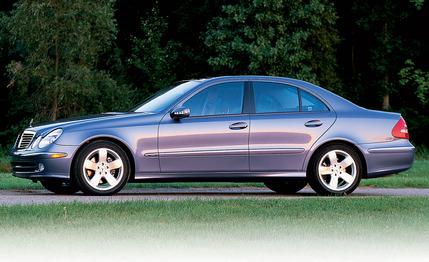 Road Test
Road Test
"Engineered like no other car in the world."
For decades that was the Mercedes motto. But under the onslaught of new competitors from Japan and a surging BMW, the company in the early 1990s moved away from the cold rationality implied by that slogan and toward a warmer, and perhaps fuzzier, image of itself. Judging by this spanking-new E500, however, we don't think anyone told the engineers about the change.
Under its stylish skin, the E500 comes standard with the Airmatic DC suspension that electronically juggles - 20 times per second, although our managing editor refuses to believe this - four stages of shock-absorber damping, two levels of air-spring stiffness, and variable ride height at all four wheels to achieve the optimal balance between ride and handling.
When the driver applies the brake pedal, he or she is actually pressing a sensor that takes the request for deceleration and separately sends precisely metered hydraulic pressure to each of the four brake calipers based on the vehicle's speed, cornering attitude, and amount of braking required. The accelerator is also connected to the engine only by electronics. As a result, the engine-management computer provides different amounts of acceleration per increment of accelerator-pedal movement for a gentle driver or a leadfoot. Even the power-steering system, which does retain a direct mechanical link to the front wheels, alters its degree of power assistance according to a series of tables burned into an EPROM in yet another microcomputer.
Lest you think all of the E500's technology has originated with the computer and electrical engineers, the new car is also graced with an unusually sleek, sturdy, and lightweight body. The hood, the trunklid, the front fenders, and the various internal panels are stamped from aluminum. Of the steel panels, 42 percent of them are formed of various high-strength steels. And some of these employ a new stamping technology that varies the thickness of the metal from 0.045 to 0.035 inch on the same body panel.
The result is an 18-percent improvement in resistance to twisting, even though the overall weight of the body structure is essentially unchanged. Meanwhile, the drag coefficient remains at the excellent 0.27 figure scored by the previous E-class, with rear lift reduced 10 percent, according to Mercedes.
None of these technical esoterica is nearly as obvious as the major restyling of this E-class. The four-eyed front end that debuted with the previous model in 1995, and which has been expanded and adapted across the Mercedes line, has now come full circle and has been updated on the original.
The new front end is laid back to form a steeper and sleeker prow, and the headlights are enhanced with clear lenses and highly detailed projector-beam lighting units. In profile, the new model is not radically different from its predecessor, but a slightly higher, more rounded roofline does produce a more coupelike ambience. In back, tapered corners and SL-like taillights are much more interesting-looking than the blocky tail of its predecessor.